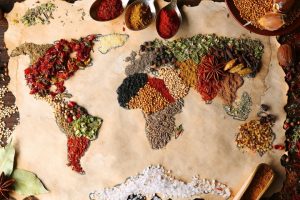Food isn’t just what we eat; it’s also an important part of many cultural identities and traditions. Different foods have their backgrounds, regions, and people who make them. Studying food from around the world can be a fun way to learn about the customs and beliefs of other groups. From the bustling street markets of Bangkok to the quaint cafes of Paris, delicious dishes are waiting to be discovered all over the world.
1. The Rich Tapestry of Asian Cuisine
Asian foods are very different from each other, just as the cultures of the continent are very different. Chinese food has a long history and emphasizes balance and unity. Dishes like dim sum, Peking duck, and hot pot are examples of this. Chinese food is often a mix of salty, sweet, sour, and spicy flavors, with an emphasis on the use of fresh ingredients and complex cooking methods.
Japanese sushi and sashimi are works of art that emphasize precision and simplicity. Japanese cuisine focuses on the use of seasonal vegetables and their presentation. Dishes like tempura and ramen are both comforting and sophisticated. On the other hand, when it comes to Korean food, foods like kimchi, bibimbap, and Korean bulgogi are known for their rich flavors and the way they are eaten together.
People love delicious and aromatic foods from Southeast Asian countries like Thailand and Vietnam. Thai food is known for its variety of flavors, such as sweet, spicy, sour, salty, etc. Green curry, pad thai, and mango sticky rice are all very popular recipes. Well-known Vietnamese recipes include pho, Vietnamese sandwiches, and spring rolls. Vietnamese cuisine is dominated by fresh herbs and light, flavorful ingredients.
2. A Wide Range of European Flavors
European countries and regions are different, and so are their foods. Everyone has their style and customs. Gastronomy is a way of life in Italy, and each region is known for its unique dishes. People all over the world love Italian food, especially pasta, pizza, and hearty sauces. Classic favorites like pasta, lasagna, and pizza Margherita are beloved by many.
France is known for its haute cuisine, with a wide variety of delicious dishes and cooking methods. French delicacies like fluffy croissants, rich pates, delicate soufflés, and fine wines are always considered refined and luxurious. French cuisine is the epitome of gourmet cooking because of its emphasis on using fresh, high-quality ingredients and beautifully presenting the food.
In Spain, the idea of tapas inspires people to eat together and share. Small plates like mashed potatoes, chorizo, and croquettes are common in Spanish cuisine, showing how diverse the country’s regions are and how vibrant its food culture is. A typical Spanish dish is paella, a rice dish usually prepared with meat or seafood. It showcases the rich flavors of the Mediterranean.
3. Learn about African Culinary Traditions
Food in Africa is very different because the country has so many different climates, resources, and cultures. West African dishes such as jollof rice, egusi soup, and plantains showcase the rich spices and hearty dishes found in the region. These meals often come in a variety of flavors and textures, demonstrating the richness of the food culture in places like Nigeria and Ghana.
East African dishes include flatbreads such as injera Ethiopian doro wat and injera chicken stew. Kenyan dishes also include hearty stews and grilled meats made with common ingredients such as vegetables, beans, and corn. The cultural values and customs of the region are reflected in the use of aromatic herbs and the way people eat together.
Spices and herbs are an important part of North African cuisine. Dishes such as tagine, couscous, and hair are famous in the region. Moroccan food is best known for its complex flavor combinations, especially slow-cooked stews and richly flavored grains.
4. How American Taste Differs
There are many different cultural groups in North America, and food traditions reflect this. Southern comfort food, Tex-Mex, and New England seafood are just a few examples of the diverse foods in the United States. Southern dishes like fried chicken, collard greens, and cornbread show how African, European, and indigenous products and methods come together.
Mexican food, such as tacos, tamales, and mole, is known for its wide variety of flavors and textures. Using fresh produce like corn, beans, and chili peppers and cooking them in traditional ways, Mexican food is delicious and deeply connected to the culture.
From Brazilian barbecue (churrasco) to Argentine empanadas and Peruvian ceviche, South America has many different food customs. Brazilian food is known for its wide variety of flavors and ingredients, including fish, tropical fruits, and different types of meat. Argentine cuisine, heavily influenced by European immigrants, focuses on beef, with dishes like asado and milanesa being popular.
Conclusion
Trying foods from around the world is an adventure because of their different flavors, customs, and stories. Each food reflects the different historical and cultural beliefs of its creator. By trying new foods from around the world, we not only improve our taste but also learn to appreciate the unity of people around the world. Like a bowl of pho, a slice of Italian pizza, or a Moroccan tagine, eating food from around the world connects us to the wide range of cultures that exist in the world.
FAQs
1. Why should I learn about food from around the world?
When you try global cultural cuisine, you can taste different flavors, foods, and cooking styles from around the world. It can help you learn about other countries and traditions, expand your culinary knowledge, and give you an appreciation for the variety of foods that exist around the world.
2. How do I start trying food from around the world?
Start by learning about and trying food from different places. There are many places where you can find recipes online, in ethnic restaurants, or at cultural food festivals. You can learn many new recipes by taking cooking classes or reading food blogs from around the world.
3. What foods are commonly used in Asian cuisine?
Soy sauce, ginger, garlic, lemongrass, fish sauce, and various spices such as star anise and Sichuan pepper are all common ingredients in Asian dishes. Asian recipes also use many staple foods such as rice, noodles, and tofu.
4. What is unique about Italian food?
Italian cuisine is known for using only fresh, high-quality produce and simple cooking methods. Pasta, olive oil, tomatoes, fresh herbs such as basil and oregano, and various types of cheese are all important components. Italian cuisine, such as pasta, pizza, and risotto, is all about flavor and texture.
5. How do you cook authentic French food at home?
Follow traditional recipes and use high-quality ingredients to create French meals that taste like they came from France. Techniques such as sautéing, braising, and baking are common in French cuisine. You can also improve your cooking skills by investing in some important kitchen tools, such as a good pan and a French rolling pin.
6. Can you name some well-known Latin American dishes?
Mexican foods such as tacos, enchiladas, empanadas, and tamales are very popular. Peruvian dishes such as ceviche and lomo saltado are also popular, as are Venezuelan dishes such as tortillas and pabellón criollo. These recipes are often rich in flavor and use fresh herbs, beans, and corn.




